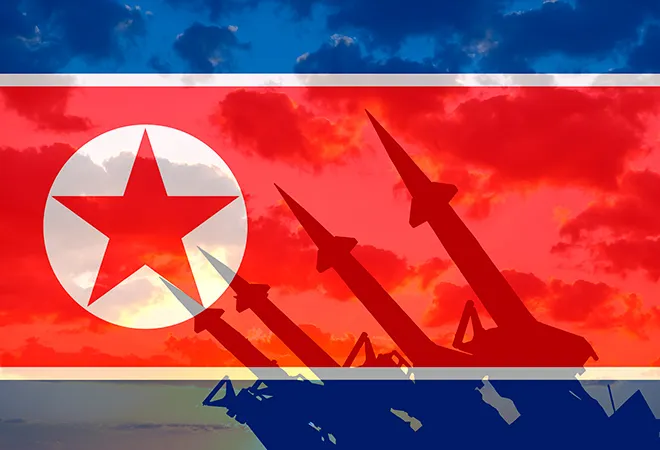
Amidst the Russia-Ukraine war, another crisis seems to be looming on the horizon as North Korea continues its missile barrage. The tension flared up on the 2
nd of November 2022 when Pyongyang fired more than a dozen missiles towards Seoul in the morning, one of which landed in South Korean territory for the first time since the Korean War (1950-53). The missiles resulted in the South Korean government issuing an air-raid warning for the island of
Ulleungdo. This prompted Seoul to respond by launching three air-to-surface missiles towards the eastern sea border of North Korea. Furthermore, the recent test-firing of North Korea’s Intercontinental Ballistic Missile (ICBM) on 18 November,
Hwasong-17, created another furore in South Korea. Citing the North Korean government, the missile rose to a level of
6,040.9 km, flew a total distance of
999.2 km in approximately
69 minutes, and landed in the East Sea. However, according to the analysts, the missile is capable of reaching the United States (US), flying up to
15,000 km if fired in the normal orbit.
Table 1: Successful missiles tested by North Korea in 2022
| Date |
Missile Name |
Missile Type |
| 10-1-2022 |
Hwasong-8 MARV |
Medium Range Ballistic Missile |
| 14-1-2022 |
Rail-Mobile KN-23 |
Short Range Ballistic Missiles |
| 16-1-2022 |
KN-24 |
Short Range Ballistic Missiles |
| 26-1-2022 |
KN-23 |
Short Range Ballistic Missiles |
| 29-1-2022 |
Hwasong-12 |
Intermediate Range Ballistic Missiles |
| 27-2-2022 |
Unknown |
Unknown |
| 24-3-2022 |
Hwasong-17 |
Inter-Continental Ballistic Missiles |
| 16-4-2022 |
Unnamed Small Solid Propellant SRBM |
Short Range Ballistic Missiles |
| 24-5-2022 |
Unknown |
Short Range Ballistic Missiles |
| 25-9-2022 |
Navalized KN-23 |
Short Range Ballistic Missiles |
| 28-9-2022 |
Unnamed Large Solid Propellant SRBM (KN-23 Mod) |
Short Range Ballistic Missiles |
| 29-9-2022 |
KN-25 |
Short Range Ballistic Missiles |
| 4-10-2022 |
New IRBM |
Intermediate Range Ballistic Missiles |
| 6-10-2022 |
KN-23 |
Short Range Ballistic Missiles |
| 9-10-2022 |
KN-25 |
Short Range Ballistic Missiles |
Source: NTI (The table does not include the missiles fired along the coast of Japan or South Korea but only includes, the successful missile test)
Though North Korea claimed that this continuous missile blitzkrieg was a response to the US-ROK military
drills, South Korea maintained that these drills have always been a part of their relations and were interrupted by the pandemic and former President Moon Jae-in’s attempts to reinstate diplomatic talks. North Korea had
previously stated that it would use nuclear missiles if necessary, including preemptive strikes, and fired missiles soon after, as mentioned above. Now, it is threatening to keep the US from providing a nuclear umbrella for South Korea by demonstrating its nuclear missile attack capability against the US. As the nuclear threat posed by North Korea becomes increasingly real, South Korea is inching closer to an “all-out nuclear response”. Because the Korean Peninsula isn’t a
bilateral issue between the South and the North or even Japan and North Korea, other parties, especially the US and China, play an extremely important role in determining the fate of the Peninsula.
South Korea attended the summit in the hope of reaching a favorable outcome with the help of the US amidst the recent onslaught of North Korean missile launches.
During the G20 Summit that was held in Bali, Indonesia, the Chinese, American, and South Korean counterparts met each other on the sidelines. South Korea attended the summit in the hope of reaching a favorable outcome with the help of the US amidst the recent onslaught of North Korean missile launches. However, the difference of opinion during the first in-person summit between US President Joe Biden and Chinese President Xi Jinping over Taiwan and North Korea
nuclear issue was clearly visible. The nuclear issue of North Korea was also the main source of disagreements between Xi and South Korean President Yoon Suk-Yeol. Both South Korea and the US wanted China to play an active role in resolving the North Korean nuclear issue. However, China responded by highlighting Pyongyang’s “
legitimate concerns,” emphasising that they must stop the deployment of the US’s strategic weapons and joint military drills. With China in its corner, after the conclusion of the G20 Summit, North Korea tested Hwasong-17. Kim Jong-Un again
reiterated that the North would “react to nukes with nuclear weapons and total confrontation with all-out confrontation.”
The changing world order
The current international system is not setting a good example for autocratic leaders such as Kim Jong-Un. Russia’s invasion of Ukraine and China’s repeated threat to absorb Taiwan might give such leaders an impression that imperialism is making a comeback, where major military powers invade neighboring states to expand their territory. A vital point to notice is that China is altering its strategy toward the Korean Peninsula. Following the signing of the Armistice Agreement after the Korean War (1950-53), China’s main role was to deter any war. However, as reunification with Taiwan occupies a predominant place under Xi’s leadership, he is using North Korea as a tool in the Taiwan situation by deserting the principle of denuclearisation. China has opted for a stronger alliance with North Korea on the nuclear issue, ensuring a win-win situation for both states. For example, if China wants to invade Taiwan, it will have another
front open with North Korea posing a military threat to both South Korea and the USA which would eventually deter the US from intervening in the Taiwan invasion. Meanwhile, this worsening world order is threatening the security of South Korea, thus, raising an important question “how has the situation aggravated to the level that the denuclearisation of the peninsula appears to be a flawed idea?” There are two important reasons for the same:
First was the diplomatic blunder by South Korea. It remained overly dependent on the US in tackling the North Korean threat. During the Cold War, the US deployed nuclear missiles in South Korea to curb any threat from its communist neighbour. However, once the Cold War ended, missiles were withdrawn which hastened the acquisition of nuclear weapons in North Korea. Simultaneously, it engaged with China economically in the hope that diplomatic and economic diversification could help bring peace to Korean Peninsula. However, be it bandwagoning with the US or balancing between the US and China, both didn’t bear fruit.
From expressing zero intention of developing nuclear weapons to only restricting it for electricity purposes to finally admitting the possession of nuclear weapons had helped them to bide their time.
Second, the deception strategy was adopted by North Korea in the early 1990s. There has been a complete switchin their nuclear doctrine since then. From expressing zero intention of developing nuclear weapons to only restricting it for electricity purposes to finally admitting the possession of nuclear weapons had helped them to bide their time. While indulging in the
denuclearisation talks with former US President Donald Trump and former South Korean President Moon Jae-In, Kim was able to test the ICBMs. This signifies how the deception strategy along with no hardline steps by the US and South Korea helped Kim in fulfilling his dream of becoming a nuclear state.
Conclusion
There is no doubt that Kim chose not to be in the same situation as Iraq and Libya. Simultaneously, these missile launches are also raising questions about the US’s extended deterrence. Currently, nobody is able to manage the crisis on the Korean Peninsula. The essence of a crisis is not the particular circumstances that led to it but the lack of suitable player to manage it. The problem is not the nuclear war but the possibility of a limited clash, as we have seen multiple times in the case of India and Pakistan. Any miscalculation could lead to a disaster, especially when dealing with leaders such as Kim. There is a need for Agreed Framework 2.0, where dialogues between North Korea, all nuclear states, and ASEAN members should happen while lifting certain economic sanctions imposed on North Korea. Kim will not completely cease his nuclear programme, thus, the framework should have common points with a memorandum for peace.
It is high time that peace is restored in the Korean Peninsula.
The views expressed above belong to the author(s). ORF research and analyses now available on Telegram! Click here to access our curated content — blogs, longforms and interviews.



 Amidst the Russia-Ukraine war, another crisis seems to be looming on the horizon as North Korea continues its missile barrage. The tension flared up on the 2nd of November 2022 when Pyongyang fired more than a dozen missiles towards Seoul in the morning, one of which landed in South Korean territory for the first time since the Korean War (1950-53). The missiles resulted in the South Korean government issuing an air-raid warning for the island of
Amidst the Russia-Ukraine war, another crisis seems to be looming on the horizon as North Korea continues its missile barrage. The tension flared up on the 2nd of November 2022 when Pyongyang fired more than a dozen missiles towards Seoul in the morning, one of which landed in South Korean territory for the first time since the Korean War (1950-53). The missiles resulted in the South Korean government issuing an air-raid warning for the island of  PREV
PREV


